The Battle of Heseke 2022: Timeline and Analysis

In Numbers
as per the SDF
Original prison population: 4000 (700 minor)
Prisoners surrendered from within the prison and rearrested: 3500
Escaped prisoners rearrested: 100
Escaped prisoners still at large: estimate 30-300 but unclear
Outside ISIS attackers: 100-300
Total ISIS deaths: 374
Total killed as given by SDF: 121 (40 soldiers, 77 prison staff, 4 civilians)
Hostages rescued: 23
Civilians displaced: 6000 (per UN Humanitarian Needs Assessment Program)
Background
The attack on the Sina’a Prison in the Ghweiran District of Heseke city is the largest ISIS coordinated attack since the final dissolution of the territorial caliphate with the fall of Baghouz in March 2019.
Over the past year or so, ISIS attacks in northeast Syria had dropped substantially and stayed low. Perhaps counterintuitively, many global observers saw this as a potential cause for concern- citing worries that ISIS was taking time to consolidate outside of AANES territory in the Syrian Government controlled Badia desert in order to gear up for a larger attack. The attack in Heseke seems to have fulfilled that prophecy. In fact, it almost came two months ago– the HAT (internal counterterrorism forces) discovered and thwarted a similarly planned attack against Sina’a prison at the beginning of November. In the ensuing raid, HAT forces confiscated 37 Kalashnikov rifles with 6,000 bullets, 2 PK machine guns with 5,000 bullets, 1 RPG and 42 rockets, 62 grenades and 11 explosive devices from ISIS sleeper cells. Since then, security forces have been on high alert. Now, we have seen that the very similar coordinated attack on Sina’a prison was carried out on January 20th was in all likelihood a follow-through of the original plan. ISIS militants have reportedly confirmed while in SDF custody that this attack was the result of at least half a year of logistical and strategic planning. In our monthly Sleeper Cell reports, RIC began to see a sharp decline in ISIS attacks through North and East Syria (NES) starting exactly six months ago- suggesting that ISIS was indeed saving their weapons and resources for a larger attack.
The location and target of the attack are all too logical- Sina’a is the largest prison holding ISIS detainees in NES. Around 4,000 men live in the former industrial college building housing the prison- in uncomfortably close quarters. The prison also houses roughly 700 boys between the ages of 12 and 17 linked to ISIS, who are housed in a separate building from the older men. The SDF has long spoken of their lack of material resources to build adequate facilities to house these populations, and the dire need for international support. When the battle ended on the 7th day, SDF spokesman Farhad Shami was clear: “we urgently need new prisons, that are larger, safer and farther away from residential areas.” The prison sat directly adjacent to the al-Zuhour neighborhood, where, it is said, many ISIS sympathizers, but also Syrians of all demographics, live. Parts of the larger Ghweiran District, which houses the prison, were under the control of ISIS for a brief periods during a fierce battle in the area in the summer of 2015.
Notably, the past few days have also seen ISIS attacks in other parts of NES, as well as attacks from the Turkish army and the Turkish-backed Syrian National Army forces on the M4 highway frontlines. Taking these attacks together provides a clearer picture of the wider security context surrounding the battle in Heseke, and the stresses on the SDF forces throughout the battle. It bears repeating that attacks on SDF controlled territory along the border of the Turkish-occupied areas in NES by Turkish-backed SNA forces are a nearly daily occurrence, and they did not cease during the battle.
While we did our best to include the most important events throughout the battle and to give a broad strokes assessment of the situation, there will of course be some gaps and some details we will have left out.
Area of Operations


Timeline of events
January 20th, 2022
The attack on Sina’a Prison began late at 7:30 pm with the explosion of a suicide car bomb outside of the prison walls, stopped from entering the compound by a cement barrier. Between 100-300 ISIS militants outside the prison then attacked the compound from multiple directions with heavy weapons including rocket launchers and machine guns, according to the SDF. A second suicide bomber detonated explosives placed on a motorcycle near the prison gate, damaging the gate and the walls, and killing some guards stationed outside, with which ISIS breached the prison compound. (The SDF later said ISIS members in custody confirmed the attackers launched from the cities of Sere Kaniye and Tel Abyad in the Turkish-occupied region of Syria to the north, as well as from Iraq.)

Simultaneously, prisoners inside began burning plastic and blankets in their cells to start a riot. The exact sequence of events inside the prison after the explosion is unclear. However, it is known that at some point during the night ISIS prisoners seized weapons inside the prison from the prison guards and proceeded to attack and kill medical staff, kitchen staff and prison guards. At least one group of rioters reached the outside prison yard. Reports from the coming days suggest that ISIS took at least 50 staff hostage at this point. Afterwards, they were able to breach the internal walls of the prison from the inside. It is highly likely the attack was coordinated between prisoners inside and outside attackers. According to SOHR, the attackers were divided into three combat units – one which attacked the prisons, one in northern Ghweiran, and one in al-Zuhour neighbourhood to the west of the prison – and were lead by Abu Miqdad al-Iraqi.
According to SDF reports, the Asayish and SDF managed to surround the prison quickly enough to apprehend 89 inmates on the outskirts of the prisons before they were able to escape. In the process, SDF reported that another 2 were killed and they confirmed 6 managed to escape to nearby neighborhoods, although in the chaos it seemed that the number of escapees much have been higher. However, the SDF maintained that the level of escapees remained low. Asayish and SDF then established a security cordon around the prison. Asayish later announced that in this initial operation, 1 Asayish fighter died and 7 were wounded, and that they managed to capture some of the attackers and pursued others throughout the adjacent al-Taqqadum neighbourhood.
Shortly after the initial explosion, another explosion went off near SADCOP fuel depot slightly to the northwest of the prison, likely as a decoy to sow confusion amongst the SDF and Asayish forces responding to the initial explosion, as well as to limit visibility for responding aircraft. Some reports claimed this was a secondary explosion caused by shrapnel from the first explosion.
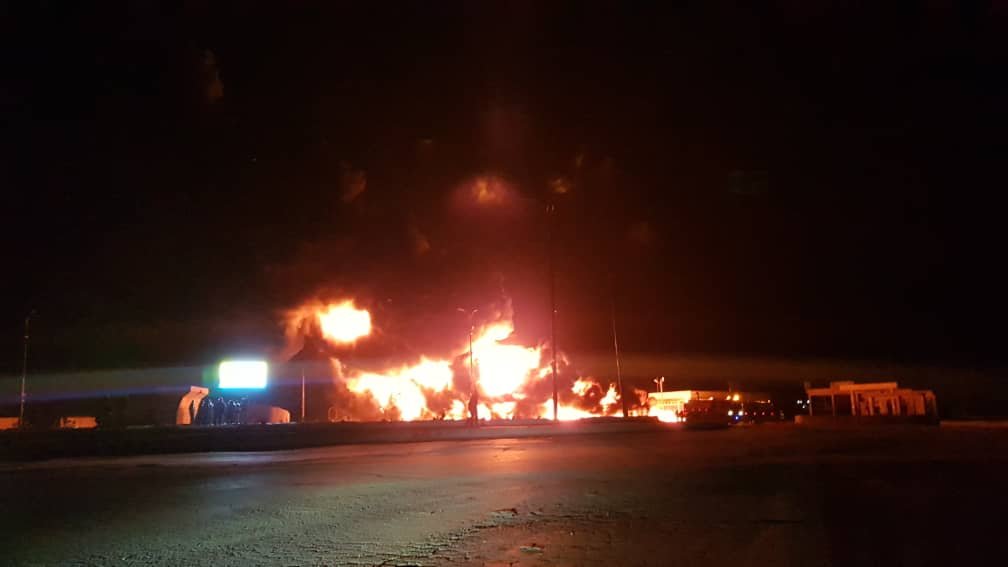
The ISIS militants who were expelled from their positions directly outside the prison spread out into the areas north and west of the prison including al-Zuhour and al-Taqqadum neighborhoods, and forced their way into civilian apartments, establishing positions to attack SDF and Asayish from the buildings onto the streets. It was reported that 5 civilians were killed by the militants (one was beheaded). According to SDF, 5 of their soldiers died on this night.
During the night, the Global Coalition began providing air support. US Apache helicopters were seen in the air over the prison and surrounding areas providing illumination flares for the Asayish and SDF ground forces.
January 21st
Clashes continued throughout the night, and by morning the SDF had established a security cordon outside the prison and had been launching offensives from the outside to reestablish control. The prison itself is a series of buildings – it is only clear that by the morning ISIS had at least complete control of the buildings in the north ward of the prison, marked on the area of operations map by a darker black square. The north ward also includes the buildings in which 700 minors (boys between 12 and 17) are housed. In the coming days, as the standoff in the prison dragged on, the SDF would issue a statement that they had particular difficulty retaking the part of the prison controlled by prisoners because they were using these boys as human shields to brunt the attack from the SDF. The fact that the boys were also stuck inside was initially not clear from the outside at this point in the crisis.
The SDF and Asayish were fighting the battle on two fronts, with prisoners inside the prison, and with teams of attackers who had established positions outside. North of the prison, a large concentration of ISIS fighters had established a position in the old Technical Institute of SAR-run Firat University, and were shooting towards the SDF positions outside. ISIS fighters had also taken control of the grain silos north of the prison and were launching attacks from there. Other ISIS fighters were scattered around the al-Zuhour and al-Taqqadum neighborhoods north and west of the prison, engaging SDF and Asayish in firefights. Meanwhile, Asayish forces combed the areas of the neighborhoods to find the escaped prisoners and root out attacking ISIS members.

All throughout the day, the US Apache helicopters were providing support to the SDF fighters on the ground with machine gun fire and rockets fired both into the prison and on ISIS positions in the surrounding areas. ISIS communication channels reported that they were held in position by these assaults. US Bradley IFV military transport vehicles were seen in the city starting mid-day. The Pentagon confirmed it carried out airstrikes on ISIS positions, though at this time it denied that there were US ground troops involved.
Throughout the day, fighting continued in these positions. The SDF reported that 12 ISIS fighters had been killed, including a Chinese (Uyghur) member, proving third-country nationals were among the ISIS ranks staging the attack. They also reported 3 SDF deaths and 15 injuries. At this time, SDF press began publishing photos of dead ISIS members with their weapons, which included rocket launchers, PK machine guns, AK 47s, and explosive vests.
For civilians in the fighting area, the SDF issued a stay-in-place order as a safety precaution given the heavy fighting in the streets. However, many civilians left the affected neighbourhoods on foot throughout the day, seeking refuge in the north of the city. The SDF set up checkpoints throughout the city to secure the foot traffic and facilitate the exit of civilians. The governor of Heseke was quoted as saying that 4,000 civilians had been internally displaced within the city, and were finding refuge in mosques, wedding halls and other community centers. The Humanitarian Needs Assessment Program of the United Nations later estimated the number at 6,000. By the afternoon, the entire city of Heseke itself was cordoned off, and no cars other than military or press could enter. The movement of traffic in the city was stopped indefinitely, while information phone lines were set up for citizens to call in with tips and questions.
In tandem, local reports claimed that ISIS had enough control over parts of al-Zuhour neighbourhood to prevent up to 300 families from leaving the area, and that they had been using civilians as human shields to move around the neighbourhood. They continued to terrorize those who tried to prevent them from entering their homes, and 3 civilians were reported dead as a result of gunfire meant to intimidate the civilian population.
Additionally, 7 prisoners were killed by ISIS elements inside the prison as they tried to surrender to the SDF.
Throughout Northeast Syria
DEIR EZ-ZOR: Attacks across the rest of northeast Syria split the SDF’s attention. By mid-afternoon, ISIS had launched a series of seemingly coordinated attacks across Deir ez-Zor, including on several checkpoints and a water station in Shuwaydan, al-Harmoshiya, al-Keber and Dhiban, on an SDF headquarters in Busayrah with an RPG and machine gun, and on the home of an SDF commander in Theban. It was later confirmed that these attacks resulted in no casualties.
TEL TAMR: At midday, a Turkish drone struck an SDF vehicle from the Tel Tamir Military Council that was on its way to provide reinforcements to the battle in Heseke. No casualties were reported by the SDF at the time.
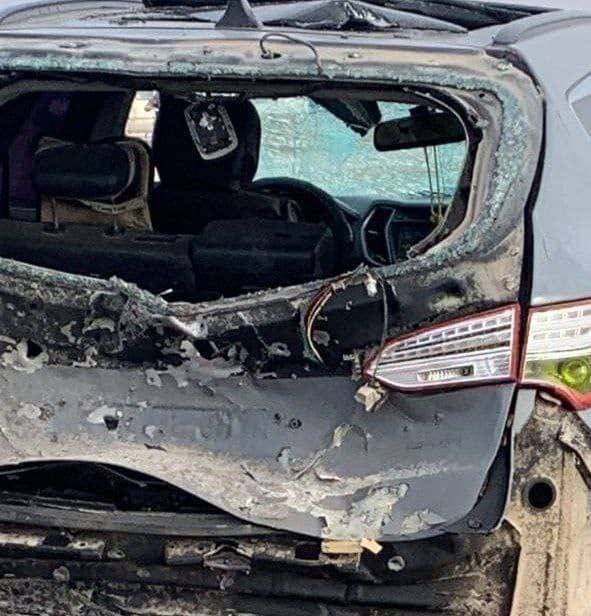
AIN ISSA: Turkish- backed SNA militias also began bombing and shelling the villages of Saleh al-Hamoud and Fatsa in Ain Issa.
January 22nd
Helicopter fire reportedly started very early in the morning, targeting ISIS positions in the grain silos. A Coalition airstrike destroys the western building of the Technical Institute in the morning, though ISIS militants would hold the eastern building until the 24th. By midday, the SDF and Asayish had retaken several points on the northern side of the prison, but the grain silos remained in ISIS hands. The SDF had continued to tighten the security cordon around the northern ward of the Sina’a prison, and to sweep al-Zuhour and al-Taqqadum neighbourhoods. At noon, the SDF issued a statement stressing the importance of capturing the resisting prisoners alive. During the day they imposed a week-long curfew within the city due to ongoing clashes, and citizens were confined to their houses.
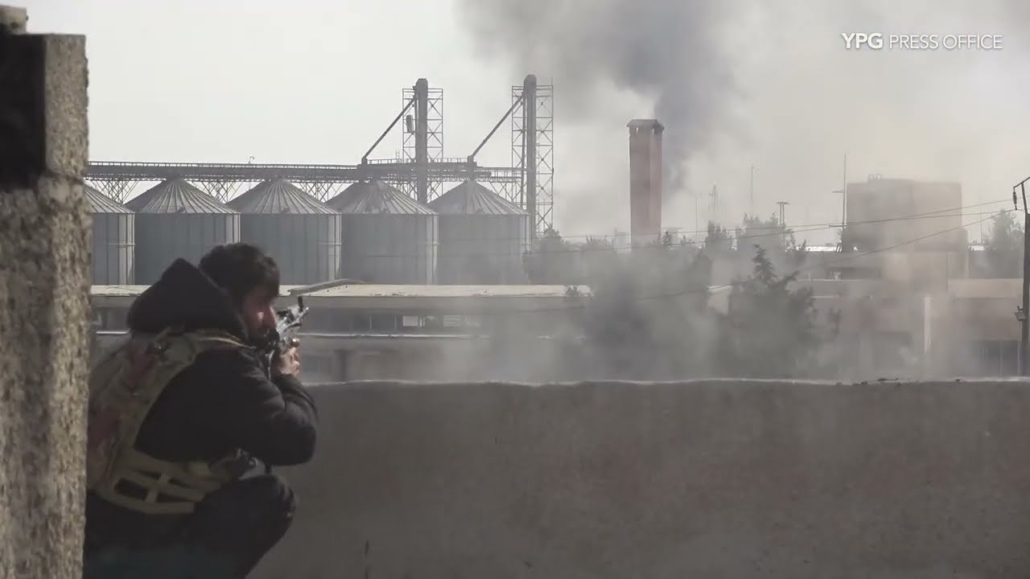
ISIS within the prison released video footage showing several abductees. The SDF confirmed these hostages were the kitchen staff of the prison, with whom the SDF had lost contact during the initial attacks on the prison. The hostages in the photo were wearing military fatigues, and they could have been Hezen Xwe Parastina service members, those doing their compulsory military service. It is believed that this video was created closer to the beginning of the attack, and released later. Starting at this point in the conflict, ISIS’ Amaq Agency began to play a larger role in the media narrative, releasing videos of the detainees inside the prison holding meetings and wearing orange headbands around their heads – likely made from their uniform jumpsuits – as a strategy to easily recognize each other in the fighting.


During the day, American troops were also definitively spotted in the city, as Bradley IFV’s crawled along the road at the perimeter of the prison. US Apache helicopters continued to provide supporting fire.

At night, 6 ISIS members who tried to escape the prison were arrested by the SDF. And the end of the day, the SDF announced that 18 fighters from across the security apparatuses of NES, including the SDF, the Asayish and the HPC (community defence forces) had fallen, including 2 Arab brothers who were SDF soldiers. They also announced that 23 had been injured, a number that included civil servants in the prison. Additionally, they announced 110 ISIS members had been captured (100 prisoners and 10 attackers) and 45 killed.
During the night there were clashes of varying intensity reported by sources inside the city, including bullet fire, airstrikes and rocket launches.
Throughout NES
SHADDADI: As a precaution, the SDF brought in reinforcements to Shaddadi and established a security cordon around the al-Kum prison, the second largest prison housing ISIS affiliates in NES.
AIN ISSA: According to SDF, at dawn, Turkish-backed SNA militias launched a ground attack on the villages of Hoshan, al-Khalidiya, al-Muallak, al-Mushirfa, Jahbal, al-Hesha, al-Salhia, al-Qadria, al-Fatsa, and Al-Arisha, resulting in killing three civilians and 11 others injured.
QAMISHLO AND HESEKE: Local hospitals begin issuing general calls for blood donations as SDF casualties mount.
January 23rd
Before noon, Coalition jets were heard over Heseke. The US planes dropped flyers encouraging citizens of Heseke to report ISIS militants and any suspected ISIS activity to the phone lines that had been set up.

Also at midday, the SDF was heard calling through loudspeakers for the ISIS fighters holed up within the prison to surrender. SDF announced they had again shrunk the perimeter to the northern wall of the prison, including the building opposite of the prison gate, and killed 13 and captured two ISIS members outside the prison.
In the afternoon, fighting continued around the northern and southern sections of the prison. SDF confirmed that ISIS continued to attack to support the prisoners inside from the al-Taqqadum neighborhood to the north.
In the late afternoon, a communiqué went out in Kurmanci stating that the SDF was in full control of the prison. This was later denied and clarified in a new communication that said they were in the final stages of taking back the prison, and that a full security cordon had been set up around the prison. The SDF then announced the latest numbers – that 175 ISIS had been killed overall during the fighting including 13 on the 23rd. This was said to include 150 attackers and 15 prisoners.
Negotiations started, through loudspeakers, encouraging the surrender of the ISIS members inside. It is likely the SDF had other lines of communication into the prison to conduct negotiations.
SDF announced that 10,000 fighters across the security apparatuses of NES – the SDF, Asayish and HPC – contributed to the fighting, but that combing operations were still going on. They also announced ISIS attackers had been moving around the neighbourhoods in hidden tunnels, which SDF had secured. 5 SDF soldiers were killed during the fighting on the 23rd. At night reports from the city came in about the local civilian population taking turns doing patrols to protect their neighbourhoods around Heseke. During the evening there were alternating periods of calm and gunfire in the neighbourhoods surrounding the prison. But as the night reached near-freezing temperatures, people curfewed at home began to run out of fuel to heat their apartments.
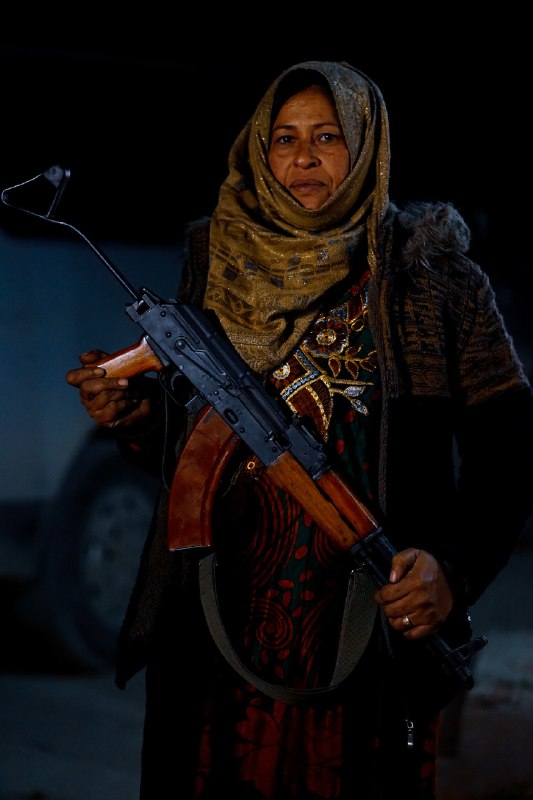
During the night the SDF continued to send messages over loudspeakers throughout the conflict zones to attackers to surrender, and some attackers within the prison and outside turned themselves over to the SDF forces.

Throughout NES
SHADDADI: In the afternoon, reports filtered in about a riot in the al-Kum prison in Shaddadi prison, which was later denied by the SDF.
AYN ISSA: An attempted attack at Bir Issa village was thwarted, in which 10 SNA soldiers were killed, and two others wounded, while two military vehicles and two headquarters were destroyed. Two civilians were killed in the SNA attack.
DEIR EZ-ZOR: A likely ISIS attack in al-Hejjnah village, Deir ez-Zor, left two wounded SDF soldiers.
January 24th
In the morning there were initial reports of 6 American airstrikes at dawn, which would later be raised to 11, with confirmation from the Coalition.

SDF continued to broadcast calls to surrender throughout the night and in the morning reports came in that 25 ISIS members had been arrested as they tried to flee from the prison or surrender to SDF. This included a reported 5 men who tried to escape dressed as women. Over the course of the day, 300 prisoners surrendered in total, and were transferred to new facilities. A military convoy with 3 buses of prisoners arrived in Qamishlo’s Alaya prison in the late afternoon.
SOHR activists reported that the total death toll since the start of Ghweiran prison break on Thursday evening had reached 154: 102 ISIS fighters, seven civilians and 45 members of Asayish Forces, prison guards and counter-terrorism forces. SDF began advancing inside the prison and managed to free 9 prison staff in the early hours of the evening. Sweeping campaigns around Ghweiran led to 17 ISIS deaths: 5 suicide bombers were killed in al-Zuhour neighbourhood; 3 attackers were killed in clashes north of Ghweiran; while another 9, including 2 suicide bombers, were killed in operations in eastern Ghweiran. 3 SDF soldiers fell during the fighting.

In a rare move, the SDF sent its T-62 tanks into Heseke to support operations. Coalition F16 jets & Apache helicopters provided air support throughout the day. Additionally, SDF forces attempt to storm the prison with the help of supporting fire by Coalition Bradleys. US and British forces were reportedly on the ground providing sniper fire & help communicating airstrike locations.
A video circulating of SDF personnel brutalizing ISIS prisoners. SDF press says the soldiers involved were stripped of their military rank and will face a court trial for “breaching the moral values and military principles of the SDF.”
SDF announced the arrest of 5 ISIS members in a village southeast of Heseke. Military sources confirmed that there were ISIS members who had spread out throughout surrounding villages, and that sweeping operations could take some time.

Throughout NES
SHADADDI: An American convoy with 14 Humvees and two tanks was spotted heading from their base in the city of Rmelan to Shadaddi.
DEIR EZ-ZOR: ISIS attacked SDF positions in the towns of Busayrah, Theban, al-Hariji, & Suhail with RPGs & machine guns. Two SDF soldiers were wounded in al-Hariji.
January 25th
Fighting inside the prison continued, as SDF tanks and armoured vehicles entered the prison compound. The YPG press office published videos of SDF Commandos, specially trained frontline soldiers, engaging ISIS fighters armed with AKs in a courtyard of the prison.
Coalition airstrikes targeted the prison in the morning. 250 more prisoners surrendered before noon, bringing the total to 550, and in the early afternoon the SDF announced it had taken control of a “block of buildings consisting of eight dormitories.” By this, they were referring to single-room cells, which often hold upwards of 30 men each. At this point, anecdotal and video evidence seemed to confirm what observers had feared – minors were among the injured inside the prison.
The Violations Documentation Center confirmed that a journalist was killed and 6 others were injured throughout the battle to date. An SDF soldier was also killed on the 25th. During ongoing negotiations with the SDF, a hostage/prisoner exchange scheme offered by the remaining ISIS elements inside the prison was resolutely rejected by the Coalition, given a policy of non-negotiation. Clashes renewed following shortly after this rejection. Combing operations in Ghweiran continued as well.

Throughout NES
RAQQA: SDF released a statement in the afternoon saying the SAR had evacuated positions it held at al-Rasafa, 40km south of Raqqa, on the border with NES. “However, our forces have taken precautionary measures to prevent Daesh from taking advantage of these evacuations, posing a threat to the perimeter of Raqqa,” the statement continues.
MANBIJ/AL-BAB: Turkish-backed SNA factions shelled al-Sayada and al-Yalanli villages in the north-western countryside of Manbij, and Al-Arima town in the eastern countryside of Al-Bab city, with over 20 mortar shells.
AL-HOL CAMP: Asayish announced the arrest of an ISIS cell consisting of 4 members in al-Hol and seized quantities of weapons and ammunition.
January 26th
The SDF was quiet throughout the morning as they conducted final operations, but independent reports emerged that ISIS still controlled three buildings within the prison. US Apache helicopters were spotted in the sky of Ghweiran district, supporting ongoing raids in al-Zuhour neighbourhood and firing into the prison with heavy machine-gun fire, which was being returned by ISIS prisoners inside. The clash stopped in conjunction with the entry of medical teams from the SDF to the prison. Following negotiations between SDF and ISIS fighters in al-Sina’a Prison, ISIS released a number of prison guards in exchange for the entry of medical teams to treat prisoners and ISIS fighters.
SDF confirmed they had safely freed 23 hostages, and video emerged of over-joyed families celebrating with their returned loved ones. 2 SDF soldiers were killed before the end of the day, including an Arab soldier from Deir ez-Zor.
Displaced people continued to congregate in primarily two locations outside of Ghweiran district, Musa’b Bin Omair mosque in Tel Hajar and Mustafa mosque in the east of the city.
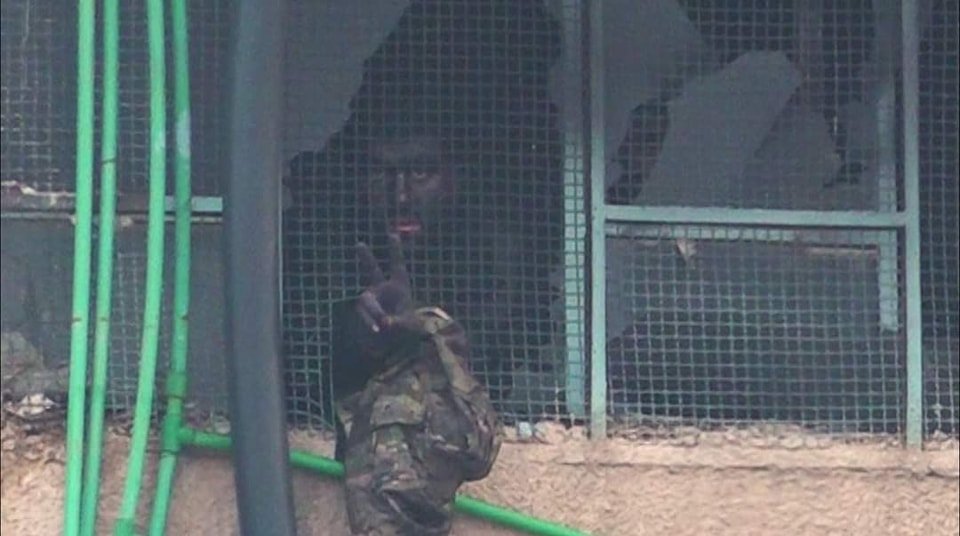


At 3 PM, SDF spokesman Farhad Shami announced via Twitter that, “The Peoples’ Hammer Operation has culminated with our entire control of the al-Sina’a prison in al-Hasaka and the surrendering of all Daesh terrorists.” This marked the official end of the operation to retake the prison. There was no official confirmation that the sweeps of the surrounding neighbourhoods and villages are over, but eyewitness reports said quiet and calm has returned to the city. According to SDF, 1,100 prisoners surrendered hours before the official end of the fighting. It is not yet known whether they form part of the 3,500 people who surrendered after the fighting. In the evening, civilians and military personnel celebrated the end of fighting in the streets of Heseke.
YPG press released a video in which soldiers speculate this operation may have taken up to $15 million dollars for ISIS to carry out, bringing further attention to the extensive resources available to the terrorist organization from funding sources as far as Europe. SDF published a press release addressing international media and NGOs explaining the status of ISIS-linked minors inside the prison. A Swedish delegation repatriated 2 Swedish women and 4 children, likely from Roj camp.
The SDF confirmed that they had pursued “terrorist cells” in the outskirts of Heseke during the night as part of a larger sweeping campaign. Furthermore, they announced that they arrested 2 suspects in the vicinity of Sina’a Prison during the night. According to some local sources, Coalition jets bombed the prison during early morning hours.
Throughout NES:
QAMISHLO: A Swedish delegation visited the Foreign Relations Office of the AANES and repatriated 2 Swedish women and 4 children who were previously being held at Roj camp. Swedish Ambassador Frederic Florn, who headed the delegation, offered his “deepest condolences to the families of the martyrs, and we feel sorry for the civilians who were displaced from their homes due to the attack launched by ISIS in detention centers,” Adding that “we appreciate the sacrifices they made here.”

January 27th
In the morning, the SDF announced they had rearrested over 3,500 prisoners in total who had surrendered from within the prison. At 10:15 they also announced that in the process of sweeping the prison they discovered an additional 60-90 prisoners who were hiding in one of the prison building’s basements. SDF offered them surrender over the loudspeaker and in the event they do not surrender, said they would be “dealt with firmly”. Observers questioned why the SDF had announced victory the night before, with some pointing out that the 26th was the anniversary of the liberation of Kobane from ISIS, and therefore symbolic. A photograph of some of the minors in the courtyard of the prison was released.
Before noon, operations to dislodge the remaining resisting prisoners continued inside the prison, while 2 ISIS attackers launched additional attacks on near Bassel roundabout. It is unknown whether the target were 6 local and international journalists, US troops, or SDF soldiers – all of whom were present at the roundabout when it was attacked. One of the attackers was arrested; the other fled. 20 more ISIS suspects were arrested overall, including 2 from within the prison, 2 in al-Zuhour neighbourhood, 3 in Aziziya neighbourhood, 3 in and around Raqqa, 2 in al-Zarr (Deir ez-Zor), and 7 in Abu al-Nitel (Deir ez-Zor). In dislodging a group of ISIS militants holed up in a bakery located in the north of the Industrial complex, opposite the cemetery, the building was almost entirely destroyed. Even as areas of the Industrial complex are swept by security forces, YPG soldiers reported that small groups of ISIS fighters would return to and hide in previously-cleared locations during the night, severely hampering the SDF’s work.
The operations to clear the Ghweiran district were ongoing throughout the day. 1 SDF soldier was killed on the 27th.

The SDF released two more statements. One revealed the identities of 11 of their fallen soldiers and claimed that over 200 ISIS attackers had come from the Turkish-occupied regions of Sere Kaniye and Tel Abyad. Another statement addressed to media and public opinion clarified the record on the so-called “Cubs of the Caliphate,” and appealed to the United Nations and UNICEF to aid repatriation efforts, especially of women and children.
January 28th
Heseke returned to relative calm on the 28th, though Coalition jets fly-bys and raids across Ghweiran continued, including raids by Special Forces in the northwest of the neighborhood, yielding 6 arrests. SDF forces also continued to comb the prison, finding the bodies of 18 of their comrades. Another SDF soldier died on the 28th. The SDF released the identities of 11 more fallen soldiers, who died between the 20th and 24th. Local news media reported in the afternoon that all ISIS members involved in the attack had been killed. Combing operations in al-Taqqadum neighborhood pushed in from the north and south. According to local sources, some of the neighborhood’s residents actively hid ISIS fugitives.

A video was released showing minors making a distress call from within the prison. It is unknown whether this video was taped before the large-scale surrender on the 26th or whether it was taped at a later date. Photos released on the 28th show a large group of what appear to be minors being led out of Sina’a Prison as part of the large surrender on the 26th.
Heseke residents continued to patrol their neighbourhoods at night.
Throughout NES:
AL-HOL CAMP: Due to fears of an attack on al-Hol camp, local security forces tightened security measures around and within the camp, including the closure of the camp to visitors and an increase in patrols within the camp.
January 29th
Throughout the morning the operation to clear the prison was ongoing, as well as operations to clear the Ghweiran district of ISIS combatants. In the morning, a British military vehicle was prevented from entering a Syrian Government-held neighbourhood near Palestine Street after they took a wrong turn. In the early afternoon, in the vicinity of Fatima al-Zahra School in north Ghweiran, ISIS combatants holding at least one hostage fired on HAT (Internal Counterterrorism) forces doing a sweep of a house with machine guns. It was later revealed that five combatants were hiding in the house. During the rescue operation, one ISIS combatant was killed by HAT forces, 2 exploded suicide their vests, while the others were arrested. 6 other ISIS fighters were arrested during raids on the 29th, while 10 more fighters from within Sina’a Prison surrendered.

No SDF casualties were reported for the 29th, though their press center released the identities of 13 more fallen soldiers.
Displaced people around the city were asked not to come back to their houses yet. RIC visited one of the IDP centers, at al-Dakhil Mosque, in north Heseke, which houses 290 Ghweiran residents (69 families), including 150 children, as well as disabled and elderly people. The center’s director told the RIC that the center was initially provided with basic necessities by neighbours, after which the AANES, the Kurdish Red Crescent, the Syrian Red Crescent, UNICEF, and local NGOs provided water, food, mattresses, blankets, and medicine. Even so, blankets, water and baby food were severely lacking. A second IDP center at the Ibn Umair Mosque, which shelters 123 families, faces similar difficulties.
Throughout NES:
DEIR EZ-ZOR: Raids in Deir ez-Zor continued. At night, the SDF announced the arrest of 5 ISIS suspects in Dhiban.
AL-HOL CAMP: A few employees of the Blumont Organization, which manages the camp, as well as Doctors Without Borders personnel, were allowed into the camp, as Asayish continue to impose a tight security cordon around the camp. Reportedly, a few tents were burning throughout the day. The reason for the fire is unknown.
January 30th
28 UN humanitarian aid trucks reached the city of Heseke with the help of Asayish and the International Coalition. 5 ISIS combatants inside the prison were reportedly killed, while an ISIS emir surrendered. In the early afternoon, the SDF announced they had re-taken the remaining buildings within the prison complex. According to their press center, 4 more SDF soldiers died during the final day of battle, including another soldier from Deir ez-Zor. Arrests continued across Heseke: 3 ISIS combatants were arrested in the neighbourhood of Aziziyah, including 2 suicide bombers and an injured fighter. SDF announced that over 100 people had been arrested during combing operations following the attempted prison break. While raids continued throughout the day and into the night, no major disturbances were reported. According to SOHR, 77 bodies were found on the 30th, of which 39 were ISIS combatants and 38 were SDF soldiers. This is as of yet unconfirmed.

Throughout NES
DEIR EZ-ZOR: Operations in Abu Hamam and Abu Hardoub resulted in the arrest of 9 ISIS suspects.
January 31st
Relative calm prevails as the SDF convenes a press conference in Heseke. Final figures for ‘Operation People’s Hammer’ were given as: 4 civilians killed, 40 SDF soldiers and 27 prison staff fallen, and 374 ISIS combatants killed. The number of SDF soldiers killed would be updated to 43 on February 6th. No final figure on those arrested was given. The Turkish state was blamed for its parallel attacks on NES, “giving ISIS the moral strength to catch its breath & regroup.” “[Turkish-]Occupied areas have also been transformed into the safest and most protected areas for ISIS to organize itself and train its elements,” it added.
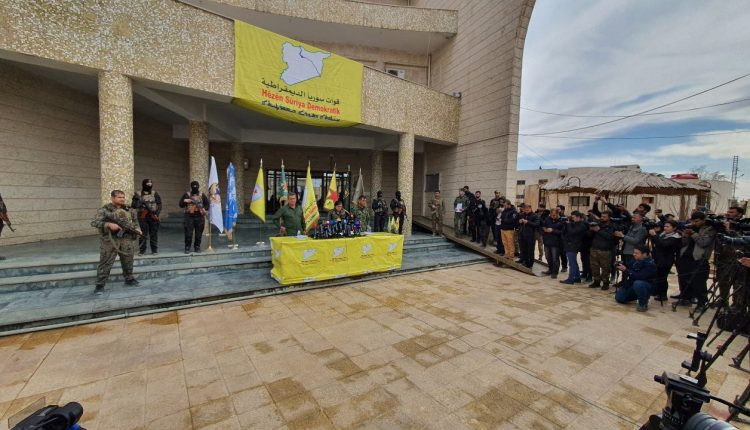
According to “the documents confiscated & the confessions [of ISIS members],” the SDF statement continued, the long-planned attack, dubbed ‘Second Islamic Caliphate’, was to unfold in conjunction with attacks across Heseke, al-Hol, Shedaddi, & Deir ez-Zor. The statement praises 2 prison guards, Cemal Kobanê and Akîf, who fell fighting off the attack and allowed the SDF and Asayish to quickly set up a tight security cordon around the industrial complex and a second parameter around Ghweiran, from which the security forces launched their offensive. The long duration of the operation, the statement reads, is attributable to the use of pre-built tunnels between houses in north Ghweiran and al-Zuhour neighbourhoods, as well as the use by ISIS of prison staff kept hostage and ISIS-linked minors as “human shields.”
Finally, the SDF thanked the International Coalition for its support, but highlighted that “there is an urgent need for international military & political assistance, particularly by the Coalition, to the SDF and AANES, and intensify the assistance by providing advanced technology to eliminate ISIS.” Shortly thereafter, a White House statement commended the SDF for their “bravery and determination,” and stated that “the United States remains committed to working with our partners in Iraq and northeast Syria.”
According to SOHR, most of the SDF & prison guard bodies found within the prison were beheaded. The ISIS attackers reportedly attempted to cremate at least 4 of the hostages in the prison’s kitchen. On February 5th, 40 families were still waiting for laboratories in Damascus to match their DNA to those of mutilated bodies found in Sina’a prison.
It is not yet known how many ISIS detainees escaped during the breakout attempt. The figure, according to SOHR sources, is anywhere between 30 and 300. What is known is that at least 4 high-ranking ISIS emirs, including Abu Dujana al-Iraqi and Abu Hamza Sharqieh, safely reached Turkish-occupied territory. Many more escapees managed to reach Turkish-occupied territory: RIC’s February Sleeper Cell Report recorded at least 4 arrests of ISIS combatants on their way to Jarablus, Sere Kaniye, or Tel Abyad. Others escaped SAR-controlled areas through Deir ez-Zor and Raqqa, or to Iraq. One source quoted by SOHR says that
“ISIS fighters transported the fugitives in civilian vehicles, some owned by ISIS fighters and some seized by them upon entering the Ghweiran neighborhood, in batches from the vicinity of the prison to the Sab’ Sakour area in the southern countryside of al-Hasakah, then through secondary roads between the al-Shaddadi and al-Hol areas, to the Tuwaimin desert in the Deir ez-Zour countryside. From there, they went to the Rawda desert on the Syrian-Iraqi border, where ISIS cells have been active.”
Displaced residents of Ghweiran began to return to their homes in the afternoon. Yet, even as of April 2022, 120 houses in the vicinity of the prison were destroyed, 62 of which were completely levelled. Affected residents will have their houses rebuilt or else receive appropriate compensation, according to the Jazeera Region Executive Council.
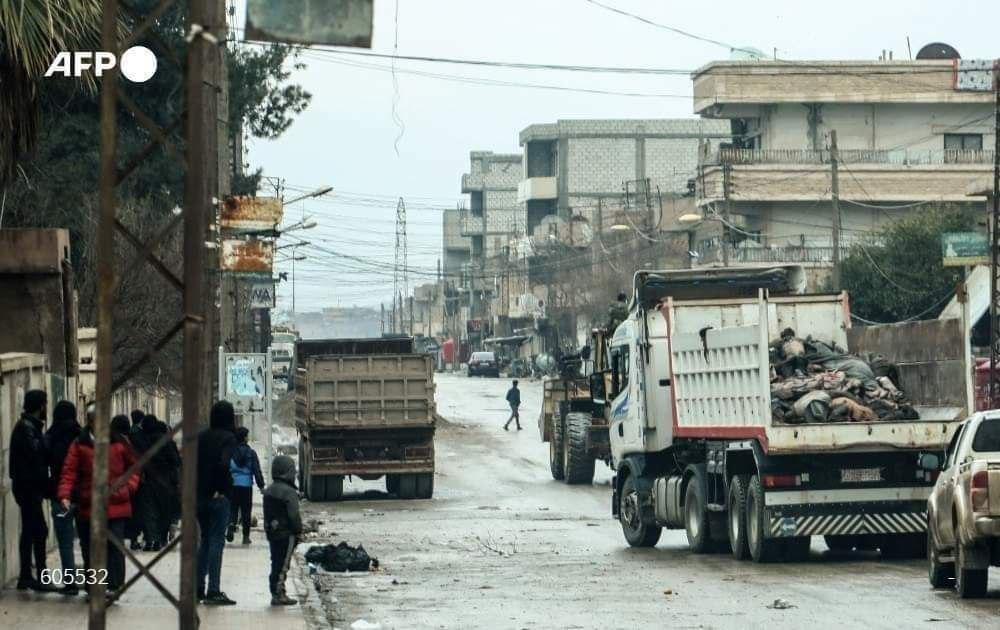
Throughout NES:
RAQQA: In the afternoon, the SDF announced the arrest of 27 ISIS suspects in a large raid across several hideouts in the region of Raqqa.
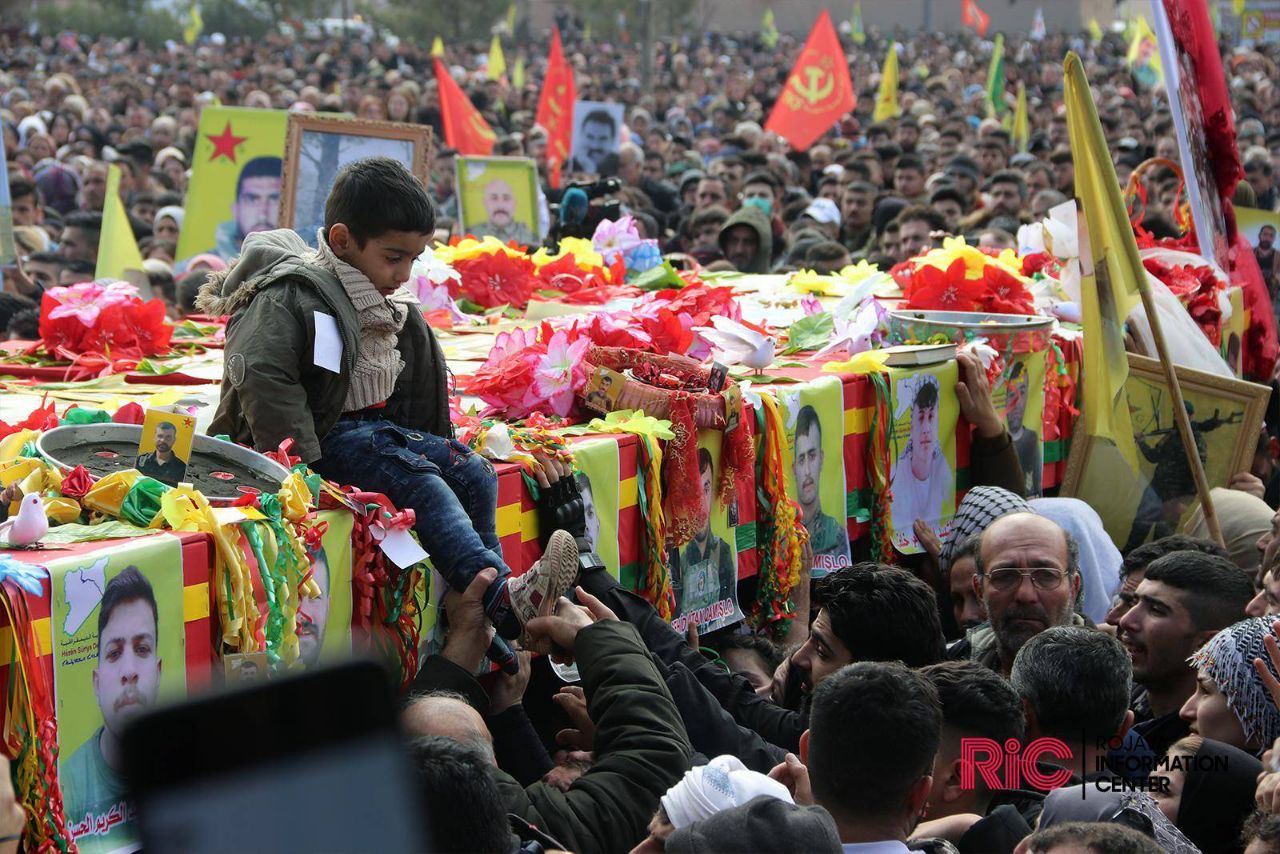

 Above: Photos from the funeral procession for fallen SDF soldiers from Qamishlo in the city, February 2nd
Above: Photos from the funeral procession for fallen SDF soldiers from Qamishlo in the city, February 2nd


Trackbacks & Pingbacks
[…] quantities of TNT were amongst the items confiscated. In the months preceding ISIS’ attempted prison outbreak in Heseke in January of this year, SDF raids uncovered similar weapons’ caches, though none of […]
[…] of January 20, the high-profile attack that killed eleven soldiers in Kirkuk the next day, the spate of attacks that bedeviled the area for days therefore after, and the groups most recent killing of Iraqi […]
[…] or detainees and guards.In January, ISIS assaulted a prison in the city of al-Hasakeh holding about 4,000 male detainees, including 700 boys, sparking a 10-day battle that according to local authorities left hundreds of […]
[…] January, ISIS assaulted a prison in the city of al-Hasakeh holding about 4,000 male detainees, including 700 boys, sparking a 10-day battle that according to local authorities left hundreds of […]
[…] had spilled into nearby neighborhoods, sending thousands of residents fleeing and causing at least seven civilian casualties. Dozens of bodies had been dumped from a front-end loader onto the street, and then shoveled into a […]
[…] had spilled into nearby neighborhoods, sending thousands of residents fleeing and causing at least seven civilian casualties. Dozens of bodies had been dumped from a front-end loader onto the street, and then shoveled into a […]
[…] had spilled into nearby neighborhoods, sending thousands of residents fleeing and causing at least seven civilian casualties. Dozens of bodies had been dumped from a front-end loader onto the street, and then shoveled into a […]
[…] had spilled into nearby neighborhoods, sending thousands of residents fleeing and causing at least seven civilian casualties. Dozens of bodies had been dumped from a front-end loader onto the street, and then shoveled into a […]
[…] had spilled into nearby neighborhoods, sending thousands of residents fleeing and causing at least seven civilian casualties. Dozens of bodies had been dumped from a front-end loader onto the street, and then shoveled into a […]
[…] had spilled into nearby neighborhoods, sending thousands of residents fleeing and causing at least seven civilian casualties. Dozens of bodies had been dumped from a front-end loader onto the street, and then shoveled into a […]
[…] had spilled into nearby neighborhoods, sending thousands of residents fleeing and causing at least seven civilian casualties. Dozens of bodies had been dumped from a front-end loader onto the street, and then shoveled into a […]
[…] had spilled into nearby neighborhoods, sending thousands of residents fleeing and causing at least seven civilian casualties. Dozens of bodies had been dumped from a front-end loader onto the street, and then shoveled into a […]
[…] had spilled into nearby neighborhoods, sending thousands of residents fleeing and causing at least seven civilian casualties. Dozens of bodies had been dumped from a front-end loader onto the street, and then shoveled into a […]
[…] had spilled into nearby neighborhoods, sending thousands of residents fleeing and causing at least seven civilian casualties. Dozens of bodies had been dumped from a front-end loader onto the street, and then shoveled into a […]
[…] had spilled into nearby neighborhoods, sending thousands of residents fleeing and causing at least seven civilian casualties. Dozens of bodies had been dumped from a front-end loader onto the street, and then shoveled into a […]
[…] had spilled into nearby neighborhoods, sending thousands of residents fleeing and causing at least seven civilian casualties. Dozens of bodies had been dumped from a front-end loader onto the street, and then shoveled into a […]
[…] had spilled into nearby neighborhoods, sending thousands of residents fleeing and causing at least seven civilian casualties. Dozens of bodies had been dumped from a front-end loader onto the street, and then shoveled into a […]
[…] had spilled into nearby neighborhoods, sending thousands of residents fleeing and causing at least seven civilian casualties. Dozens of bodies had been dumped from a front-end loader onto the street, and then shoveled into a […]
[…] had spilled into nearby neighborhoods, sending thousands of residents fleeing and causing at least seven civilian casualties. Dozens of bodies had been dumped from a front-end loader onto the street, and then shoveled into a […]
[…] had spilled into nearby neighborhoods, sending thousands of residents fleeing and causing at least seven civilian casualties. Dozens of bodies had been dumped from a front-end loader onto the street, and then shoveled into a […]
[…] had spilled into nearby neighborhoods, sending thousands of residents fleeing and causing at least seven civilian casualties. Dozens of bodies had been dumped from a front-end loader onto the street, and then shoveled into a […]
[…] had spilled into nearby neighborhoods, sending thousands of residents fleeing and causing at least seven civilian casualties. Dozens of bodies had been dumped from a front-end loader onto the street, and then shoveled into a […]
[…] had spilled into nearby neighborhoods, sending thousands of residents fleeing and causing at least seven civilian casualties. Dozens of bodies had been dumped from a front-end loader onto the street, and then shoveled into a […]
[…] had spilled into nearby neighborhoods, sending thousands of residents fleeing and causing at least seven civilian casualties. Dozens of bodies had been dumped from a front-end loader onto the street, and then shoveled into a […]
[…] had spilled into nearby neighborhoods, sending thousands of residents fleeing and causing at least seven civilian casualties. Dozens of bodies had been dumped from a front-end loader onto the street, and then shoveled into a […]
[…] had spilled into nearby neighborhoods, sending thousands of residents fleeing and causing at least seven civilian casualties. Dozens of bodies had been dumped from a front-end loader onto the street, and then shoveled into a […]
[…] had spilled into nearby neighborhoods, sending thousands of residents fleeing and causing at least seven civilian casualties. Dozens of bodies had been dumped from a front-end loader onto the street, and then shoveled into a […]
[…] had spilled into nearby neighborhoods, sending thousands of residents fleeing and causing at least seven civilian casualties. Dozens of bodies had been dumped from a front-end loader onto the street, and then shoveled into a […]
[…] had spilled into nearby neighborhoods, sending thousands of residents fleeing and causing at least seven civilian casualties. Dozens of bodies had been dumped from a front-end loader onto the street, and then shoveled into a […]
[…] had spilled into nearby neighborhoods, sending thousands of residents fleeing and causing at least seven civilian casualties. Dozens of bodies had been dumped from a front-end loader onto the street, and then shoveled into a […]
[…] had spilled into nearby neighborhoods, sending thousands of residents fleeing and causing at least seven civilian casualties. Dozens of bodies had been dumped from a front-end loader onto the street, and then shoveled into a […]
[…] had spilled into nearby neighborhoods, sending thousands of residents fleeing and causing at least seven civilian casualties. Dozens of bodies had been dumped from a front-end loader onto the street, and then shoveled into a […]
[…] had spilled into nearby neighborhoods, sending thousands of residents fleeing and causing at least seven civilian casualties. Dozens of bodies had been dumped from a front-end loader onto the street, and then shoveled into a […]
[…] had spilled into nearby neighborhoods, sending thousands of residents fleeing and causing at least seven civilian casualties. Dozens of bodies had been dumped from a front-end loader onto the street, and then shoveled into a […]
[…] had spilled into nearby neighborhoods, sending thousands of residents fleeing and causing at least seven civilian casualties. Dozens of bodies had been dumped from a front-end loader onto the street, and then shoveled into a […]
[…] had spilled into nearby neighborhoods, sending thousands of residents fleeing and causing at least seven civilian casualties. Dozens of bodies had been dumped from a front-end loader onto the street, and then shoveled into a […]
[…] had spilled into nearby neighborhoods, sending thousands of residents fleeing and causing at least seven civilian casualties. Dozens of bodies had been dumped from a front-end loader onto the street, and then shoveled into a […]
[…] had spilled into nearby neighborhoods, sending thousands of residents fleeing and causing at least seven civilian casualties. Dozens of bodies had been dumped from a front-end loader onto the street, and then shoveled into a […]
[…] had spilled into nearby neighborhoods, sending thousands of residents fleeing and causing at least seven civilian casualties. Dozens of bodies had been dumped from a front-end loader onto the street, and then shoveled into a […]
[…] had spilled into nearby neighborhoods, sending thousands of residents fleeing and causing at least seven civilian casualties. Dozens of bodies had been dumped from a front-end loader onto the street, and then shoveled into a […]
[…] had spilled into nearby neighborhoods, sending thousands of residents fleeing and causing at least seven civilian casualties. Dozens of bodies had been dumped from a front-end loader onto the street, and then shoveled into a […]
[…] had spilled into nearby neighborhoods, sending thousands of residents fleeing and causing at least seven civilian casualties. Dozens of bodies had been dumped from a front-end loader onto the street, and then shoveled into a […]
[…] had spilled into nearby neighborhoods, sending thousands of residents fleeing and causing at least seven civilian casualties. Dozens of bodies had been dumped from a front-end loader onto the street, and then shoveled into a […]
[…] had spilled into nearby neighborhoods, sending thousands of residents fleeing and causing at least seven civilian casualties. Dozens of bodies had been dumped from a front-end loader onto the street, and then shoveled into a […]
[…] had spilled into nearby neighborhoods, sending thousands of residents fleeing and causing at least seven civilian casualties. Dozens of bodies had been dumped from a front-end loader onto the street, and then shoveled into a […]
[…] had spilled into nearby neighborhoods, sending thousands of residents fleeing and causing at least seven civilian casualties. Dozens of bodies had been dumped from a front-end loader onto the street, and then shoveled into a […]
[…] had spilled into nearby neighborhoods, sending thousands of residents fleeing and causing at least seven civilian casualties. Dozens of bodies had been dumped from a front-end loader onto the street, and then shoveled into a […]
[…] had spilled into nearby neighborhoods, sending thousands of residents fleeing and causing at least seven civilian casualties. Dozens of bodies had been dumped from a front-end loader onto the street, and then shoveled into a […]
[…] had spilled into nearby neighborhoods, sending thousands of residents fleeing and causing at least seven civilian casualties. Dozens of bodies had been dumped from a front-end loader onto the street, and then shoveled into a […]
[…] had spilled into nearby neighborhoods, sending thousands of residents fleeing and causing at least seven civilian casualties. Dozens of bodies had been dumped from a front-end loader onto the street, and then shoveled into a […]
[…] had spilled into nearby neighborhoods, sending thousands of residents fleeing and causing at least seven civilian casualties. Dozens of bodies had been dumped from a front-end loader onto the street, and then shoveled into a […]
[…] had spilled into nearby neighborhoods, sending thousands of residents fleeing and causing at least seven civilian casualties. Dozens of bodies had been dumped from a front-end loader onto the street, and then shoveled into a […]
[…] had spilled into nearby neighborhoods, sending thousands of residents fleeing and causing at least seven civilian casualties. Dozens of bodies had been dumped from a front-end loader onto the street, and then shoveled into a […]
[…] had spilled into nearby neighborhoods, sending thousands of residents fleeing and causing at least seven civilian casualties. Dozens of bodies had been dumped from a front-end loader onto the street, and then shoveled into a […]
[…] المتحدة ضد داعش خلفت أكثر من 500 قتيل. كان السجن يضم نحو 4 آلاف سجين يُشتبه بانتمائهم إلى داعش أو أفراد من […]
[…] RIC – enero 2022 – Traducido por Rojava Azadi Madrid […]
[…] Para leer el informe completo de RIC (en su versión en inglés), click aquí […]
[…] Para leer el informe completo de RIC (en su versión en inglés), click aquí […]
Comments are closed.